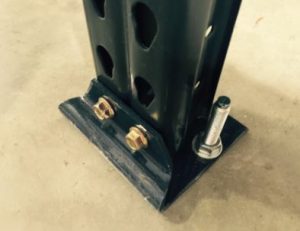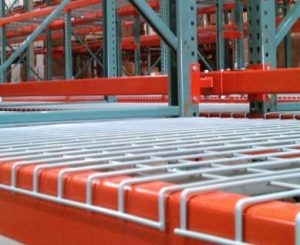I walk through a lot of warehouses, and I look at a lot of pallet racking. I have seen thousands of racking systems, some are obviously designed and installed by experienced professionals skilled in their trade. Others….well, let’s just say the design and installation could be better.
This is typically due to the racking being installed, relocated, or adjusted by warehouse personnel or other contractors who are not too familiar with pallet racking. A qualified supplier, like Abel Womack, is the best choice to help reconfigure and maintain your racking system plus make adjustments and repairs as needed. Yet many managers prefer to go it alone. For those instances, I’ve provided some helpful insight below.
No Anchors
Yes, most, if not all racking systems require anchors. This is a common question from customers. Even if the rack is short, the manufacturers require the uprights be anchored for stability. And don’t fill in all of the holes. Typically, you only need one anchor per leg. The other hole is for future use if a repair is needed, or if the first anchor hits an obstruction.
rack is short, the manufacturers require the uprights be anchored for stability. And don’t fill in all of the holes. Typically, you only need one anchor per leg. The other hole is for future use if a repair is needed, or if the first anchor hits an obstruction.
No Pallet Supports on Structural Rack
Structural, C channel beams are very strong, and typically hold more capacity than a roll formed beam of the same size. But one disadvantage of a C channel versus a roll formed boxed design is that C channels can twist, which leads to failure. Because of this, at least one pallet support is typically needed in the center of the shelf to eliminate the possibility of the beams twisting. Most structural manufacturers will design their systems with two supports per pallet position to both strengthen the beam and support the pallet.
No Wire Decks
To be clear, wire decks, or any decking for that matter, are usually not necessary. However, they often are a HUGE improvement and well worth the extra cost. If you have ever dropped a pallet on a high shelf because it was not set properly, you know why they are important. Add wire decks to your system and you won’t need to fish a pallet and product out ever again. Better yet, pallet putaway also will be faster!
well worth the extra cost. If you have ever dropped a pallet on a high shelf because it was not set properly, you know why they are important. Add wire decks to your system and you won’t need to fish a pallet and product out ever again. Better yet, pallet putaway also will be faster!
Plywood Decks
Plywood works great as a shelf deck. It drops in the steps of roll formed beams nicely and is readily available at your local lumber yard. However, it is a not a good choice for decking. If there were ever a fire, the plywood becomes a roof over the content of the racking, keeping the water from the fire suppression system from reaching those loads. Wire decking is a much better choice.
Wall Ties
This is a bit of a grey area, but I generally discourage the use of wall ties. The reason is that the rack system and buildings are both designed independently and connecting them together can negatively affect both the rack and the buildings’ resistance to seismic events. Furthermore, consider the weight of the palletized loads in the row of rack. Was that building column designed to support another 40, 50 or 100,000 pounds of weight? Probably not. An Engineering study is the best way to be sure the wall tie is appropriate.
Uprights Backwards
This is a minor issue, but still worth pointing out. The lowest diagonal brace in the upright frame should always angle down toward the travel aisle. This is because the bottom front of the upright frames sees the most impacts, and the angle brace connection increases the damage resistance of the upright. It also looks better when they are installed consistently, and correctly.
Shelf Adjustments
It is easy to adjust shelf levels in roll formed racking. Because of this, as stored product height changes, customers often adjust shelves on their own, or hire an installer to do so. It is important to remember that upright capacities are based on shelf spacing. As the shelf spacing from the floor increases, the capacity of the upright decreases. Therefore, if you move a shelf from 48” off the floor to 96” off the floor so you can double stack loads, you have probably reduced the weight capacity of the system by over 50%. Whenever shelves are adjusted, your racking supplier should be contacted to review the changes.
Some customers will always install, move, and adjust their own racking, but utilizing the experience of a qualified racking supplier like Abel Womack will help ensure you avoid these pitfalls, and optimize your racking to its full potential.



Leave a Reply
You must be logged in to post a comment.